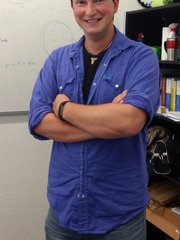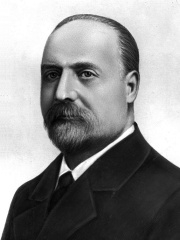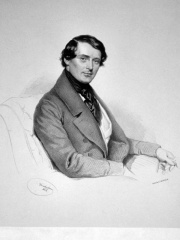


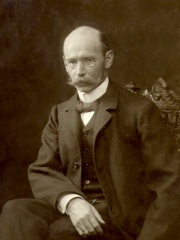

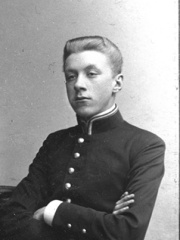
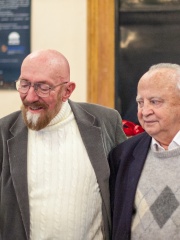

The Most Famous
ASTRONOMERS from Russia
This page contains a list of the greatest Russian Astronomers. The pantheon dataset contains 644 Astronomers, 19 of which were born in Russia. This makes Russia the birth place of the 8th most number of Astronomers behind Japan, and Netherlands.
Top 10
The following people are considered by Pantheon to be the top 10 most legendary Russian Astronomers of all time. This list of famous Russian Astronomers is sorted by HPI (Historical Popularity Index), a metric that aggregates information on a biography's online popularity. Visit the rankings page to view the entire list of Russian Astronomers.

1. Nikolai Chernykh (1931 - 2004)
With an HPI of 64.76, Nikolai Chernykh is the most famous Russian Astronomer. His biography has been translated into 40 different languages on wikipedia.
Nikolai Stepanovich Chernykh (Russian: Никола́й Степа́нович Черны́х, IPA: [nʲɪkɐˈlaj sʲtʲɪˈpanəvʲɪtɕ tɕɪrˈnɨx]; 6 October 1931 – 25 May 2004) was a Russian-born Soviet astronomer and discoverer of minor planets and comets at the Crimean Astrophysical Observatory in Nauchnyi, Crimea.

2. Lyudmila Chernykh (1935 - 2017)
With an HPI of 63.23, Lyudmila Chernykh is the 2nd most famous Russian Astronomer. Her biography has been translated into 37 different languages.
Lyudmila Ivanivna Chernykh (Ukrainian: Людмила Іванівна Черних; Russian: Людми́ла Ива́новна Черны́х; June 13, 1935 – July 28, 2017) was a Ukrainian-Russian-Soviet astronomer, wife and colleague of Nikolai Stepanovich Chernykh, and a prolific discoverer of minor planets.

3. Sergey Belyavsky (1883 - 1953)
With an HPI of 63.09, Sergey Belyavsky is the 3rd most famous Russian Astronomer. His biography has been translated into 30 different languages.
Sergey Ivanovich Belyavsky (Russian: Серге́й Ива́нович Беля́вский; December 7, 1883 (Julian calendar: November 25) – October 13, 1953) was a Soviet/Russian astronomer and a discoverer of 36 numbered minor planets. His last name is also alternatively spelled Beljavskij (name under which the Minor Planet Center credits him) or Beljawskij. His first name is occasionally given as "Sergius". He was born in St. Petersburg and was a member of the Academy of Sciences of the Soviet Union. His field of work included astrophotometry, astrometry, and the study of variable stars. He died in Leningrad. He discovered the bright naked-eye comet C/1911 S3 (Beljawsky), also known according to the nomenclature of the time as "Comet 1911 IV" or "Comet 1911g". Belyavsky observed at Simeiz Observatory (Симеиз) in Crimea. Between 1937 and 1944, Belyavsky was the seventh director of the Pulkovo Observatory, where he succeeded Boris Gerasimovich.

4. Hermann von Struve (1854 - 1920)
With an HPI of 61.37, Hermann von Struve is the 4th most famous Russian Astronomer. His biography has been translated into 20 different languages.
Karl Hermann von Struve (3 October [O.S. 21 September] 1854 – 12 August 1920) was a Baltic German astronomer. In Russian, his name is sometimes given as German Ottovich Struve (Герман Оттович Струве) or German Ottonovich Struve (Герман Оттонович Струве). Hermann von Struve was a part of the famous group of astronomers from the Struve family, which also included his grandfather Friedrich Georg Wilhelm von Struve, father Otto Wilhelm von Struve, brother Ludwig Struve and nephew Otto Struve. Unlike other astronomers of the Struve family, Herman spent most of his career in Germany. Continuing the family tradition, Struve's research was focused on determining the positions of stellar objects. He was particularly known for his work on satellites of planets of the Solar System and development of the intersatellite method of correcting their orbital position. The mathematical Struve function is named after him.

5. Lyudmila Zhuravleva (b. 1946)
With an HPI of 59.34, Lyudmila Zhuravleva is the 5th most famous Russian Astronomer. Her biography has been translated into 30 different languages.
Lyudmila Vasilyevna Zhuravleva (Russian: Людмила Васильевна Журавлёва, Ukrainian: Людмила Василівна Журавльова, romanized: Liudmyla Vasylivna Zhuravlova; born 22 May 1946) is a Soviet, Russian and Ukrainian astronomer, who worked at the Crimean Astrophysical Observatory in Nauchnij, where she discovered 213 minor planets. She also serves as president of the Crimean branch of the "Prince Clarissimus Aleksandr Danilovich Menshikov Foundation" (which was founded in May 1995 in Berezovo, and is not the same as the "Menshikov Foundation" children's charity founded by Anthea Eno, the wife of Brian Eno). She has discovered a number of asteroids, including the Trojan asteroid 4086 Podalirius and asteroid 2374 Vladvysotskij. Zhuravleva is ranked 43 in the Minor Planet Center's list of those who have discovered minor planets. She is credited with having discovered 200, and co-discovered an additional 13 between 1972 and 1992. In the rating of minor planet discoveries, she is listed in 57th place out of 1,429 astronomers. The main-belt asteroid 26087 Zhuravleva, discovered by her colleague Lyudmila Karachkina at Nauchnij, was named in her honour.

6. Nikolai Aleksandrovich Kozyrev (1908 - 1983)
With an HPI of 58.92, Nikolai Aleksandrovich Kozyrev is the 6th most famous Russian Astronomer. His biography has been translated into 17 different languages.
Nikolai Alexandrovich Kozyrev (Russian: Никола́й Алекса́ндрович Ко́зырев; 2 September 1908 – 27 February 1983) was a Soviet Russian astronomer and astrophysicist.

7. Benjamin Jekhowsky (1881 - 1975)
With an HPI of 58.77, Benjamin Jekhowsky is the 7th most famous Russian Astronomer. His biography has been translated into 20 different languages.
Benjamin Jekhowsky (Russian: Вениамин Павлович Жеховский; born 1881 in Saint-Petersburg, Russia – died in 1975, Encausse-les-Thermes,France) was a Russian-French astronomer, born in Saint-Petersburg in a noble family of a Russian railroad official. After attending Moscow University, he worked at the Paris Observatory beginning in 1912. Later he worked at the Algiers Observatory (at the time, Algeria was a colony of France), where he became known as a specialist in celestial mechanics. After 1934, he appears to have begun signing scientific articles as Benjamin de Jekhowsky. The Minor Planet Center credits his discoveries under the name "B. Jekhovsky" (with a v). In modern English transliteration, his name would be written as Zhekhovskii or Zhekhovsky. He discovered 12 numbered minor planets, made more than 190 scientific publications and the asteroid 1606 Jekhovsky is named after him.

8. Igor Dmitriyevich Novikov (b. 1935)
With an HPI of 58.47, Igor Dmitriyevich Novikov is the 8th most famous Russian Astronomer. His biography has been translated into 19 different languages.
Igor Dmitriyevich Novikov (Russian: И́горь Дми́триевич Но́виков; born November 10, 1935) is a Russian theoretical astrophysicist and cosmologist. Novikov put forward the idea of white holes in 1964. He also formulated the Novikov self-consistency principle in the mid-1980s, a contribution to the theory of time travel. Novikov moved to Copenhagen, Denmark, where he worked and taught at the Niels Bohr Institute. He returned to Russia in 2001.

9. Vera Gaze (1899 - 1954)
With an HPI of 58.16, Vera Gaze is the 9th most famous Russian Astronomer. Her biography has been translated into 18 different languages.
Vera Fedorovna Gaze (Russian: Вера Фёдоровна Газе; 29 December 1899 – 3 October 1954) was a Russian astronomer who studied emission nebula and minor planets. She discovered around 150 new nebulae and was posthumously honored by the minor planet 2388 Gaze and the Gaze Crater on Venus, both of which are named after her.
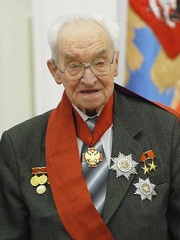
10. Vladimir Kotelnikov (1908 - 2005)
With an HPI of 56.93, Vladimir Kotelnikov is the 10th most famous Russian Astronomer. His biography has been translated into 20 different languages.
Vladimir Aleksandrovich Kotelnikov (Russian: Владимир Александрович Котельников; 6 September 1908 – 11 February 2005) was an information theory and radar astronomy pioneer from the Soviet Union. He was elected a member of the Russian Academy of Sciences in the Department of Technical Science (radio technology) in 1953. From 30 July 1973 to 25 March 1980 Kotelnikov served as chairman of the Supreme Soviet of the RSFSR.
People
Pantheon has 19 people classified as Russian astronomers born between 1811 and 1986. Of these 19, 4 (21.05%) of them are still alive today. The most famous living Russian astronomers include Lyudmila Zhuravleva, Igor Dmitriyevich Novikov, and Lyudmila Karachkina. The most famous deceased Russian astronomers include Nikolai Chernykh, Lyudmila Chernykh, and Sergey Belyavsky. As of April 2024, 1 new Russian astronomers have been added to Pantheon including Konstantin Batygin.
Living Russian Astronomers
Go to all RankingsLyudmila Zhuravleva
1946 - Present
HPI: 59.34
Igor Dmitriyevich Novikov
1935 - Present
HPI: 58.47
Lyudmila Karachkina
1948 - Present
HPI: 56.18
Konstantin Batygin
1986 - Present
HPI: 39.77
Deceased Russian Astronomers
Go to all RankingsNikolai Chernykh
1931 - 2004
HPI: 64.76
Lyudmila Chernykh
1935 - 2017
HPI: 63.23
Sergey Belyavsky
1883 - 1953
HPI: 63.09
Hermann von Struve
1854 - 1920
HPI: 61.37
Nikolai Aleksandrovich Kozyrev
1908 - 1983
HPI: 58.92
Benjamin Jekhowsky
1881 - 1975
HPI: 58.77
Vera Gaze
1899 - 1954
HPI: 58.16
Vladimir Kotelnikov
1908 - 2005
HPI: 56.93
Aristarkh Belopolsky
1854 - 1934
HPI: 56.66
Pelageya Shajn
1894 - 1956
HPI: 55.84
Matvey Gusev
1826 - 1866
HPI: 54.77
Karl Ludwig Littrow
1811 - 1877
HPI: 53.95
Newly Added Russian Astronomers (2025)
Go to all RankingsOverlapping Lives
Which Astronomers were alive at the same time? This visualization shows the lifespans of the 15 most globally memorable Astronomers since 1700.


